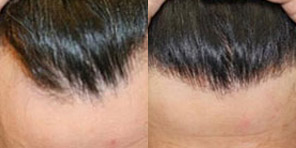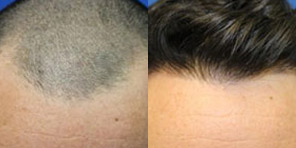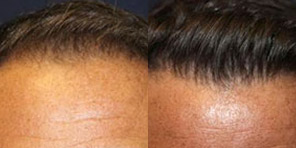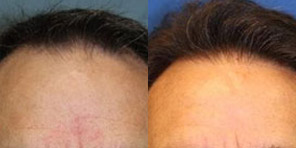Hair Matrix System
Consultations offered at our four convenient locations in La Jolla, San Diego, Newport Beach and Beverly Hills

The Hair Metrix System is an advanced digital imaging technology that allows surgeons the ability to analyze the progression of a patient’s hair loss and to evaluate the success of their treatment. By utilizing this innovative technology, both surgeons and patients can determine the most effective strategies for hair restoration. At California Hair MD, our patients have the combined benefits of a triple-board certified plastic surgeon and board-certified dermatologist, both hair restoration specialists, as well as an array of the most advanced technology for unparalleled care. We have offices located in San Diego, La Jolla, Newport Beach, and Beverly Hills. Schedule a complimentary consultation to learn more, and finally take control of your hair loss.
Contents
Diagnosing Hair Loss

A critical part of the hair consultation process includes an examination and evaluation of the donor area which supplies the hair follicles needed for transplantation. Also, it is just as important for the surgeon to examine the recipient area(s) that are losing hair and the sites where the transplanted hair follicles will be placed during the hair restoration procedure. The traditional method of examining the scalp and hair follicles in these two important areas has involved the use of a handheld dermoscope. This device magnifies the surface of the scalp and helps the surgeon to make the correct diagnosis of the patient’s hair loss. The quality of the hair follicles can be evaluated from the donor area to help determine how suitable they are for harvesting. Similarly, the scalp and hair follicles in the recipient area(s) can be examined to determine how suitable these areas are for transplantation.
Unfortunately, there are limitations to the use of a traditional dermoscope. The handheld dermoscope provides a general overview of both the donor and recipient scalp and hair follicles. However, it cannot quantify nor create a mathematical calculation of the various types of hair follicles present. This information is critical for the surgeon to accurately establish whether the patient is a good surgical candidate or best treated with medical therapy. The traditional dermoscope cannot quantify and accurately track the patient’s progress and response to either medical or surgical treatment.
However, all that has changed. Canfield Scientific has created the first artificially intelligent real-time analysis of scalp hair loss using digital technology. This system uses high-resolution trichoscopic imaging with automatic digital image analysis. This hair analysis does not require shaving the hair or waiting for the results from an outside lab as the results are immediate. Live images of the scalp are created with magnification from 15-200X. This computer analysis evaluates the two types of hair follicles that exist in the scalp: terminal hairs and vellus hairs. Terminal hairs are the healthy hairs that remain during your lifetime and are the hair follicles chosen for harvesting and transplantation. Vellus hairs are those hairs which undergo miniaturization and ultimately stop growing; these are the hairs that cause balding or alopecia. In alopecia, certain terminal hairs undergo miniaturization and become vellus hairs.
The Hair Metrix Advantage
The Hair Metrix system can identify and quantify the terminal and vellus hairs in every region of the scalp. There are several parameters that are measured by this system.
Terminal to Vellus Hair Ratio
Hair Metrix can compare the amount of terminal hairs present versus the amount of vellus hairs. The higher the ratio the more hairs are terminal versus vellus hairs, and vice versa. A high ratio is a good sign when evaluating the donor region for harvesting. This indicates that most of the hair follicles which will be harvested are terminal hairs and likely to remain on a permanent basis once they are transplanted to areas of baldness. However, the same high ratio in the recipient area might suggest that medical therapy versus surgery is a better alternative as transplantation in relatively dense scalp may permanently damage existing healthy terminal follicles.
Predict Density
Secondly, the average hairs per follicular unit is calculated. This is important since the more hairs that are present per follicular unit in the donor region means more hairs are available for transplantation creating more density in the transplanted area. Third, the system measures the average hair width which can also predict final density after transplantation. Patients with fine hair have a lower hair width than patients with coarse hair indicating that the final perceived density of a transplant may appear less in someone with fine versus coarse hair.
Identifying Optimal Donor Areas
Finally, the Hair Metrix system measures the average follicular count per cm2. This final measurement is especially important when evaluating the suitability of the donor area for harvesting. Donor density of 60 follicular units/cm2 is considered an average density from several studies (1,2) and adequate when evaluating the donor area as suitable for harvesting grafts for transplantation. The patient is provided a printed copy of the results after the consultation is completed. Most importantly, this study can be repeated during the patient’s treatment to track their progress and response to medical and/or surgical therapy. The Hair Metrix system has been used in the clinical research of alopecia by numerous international authorities on the medical evaluation and treatment of hair loss due to a variety of causes. (3,4,5,6)
There are other hair measurement systems that are available to physicians. The Tricho Lab system also uses digital trichoscopy of the scalp to create images which are then evaluated for multiple hair parameters including hair shaft thickness, number of follicular units/cm2, hair/follicular unit, and ratio of terminal to vellus hairs amongst other parameters. However, the results of trichoscopy are not available immediately to the doctor and patient. Instead, the images must be sent to a lab for a detailed analysis which can take several days before a final report is available. The Tricho Lab system has been used in numerous clinical studies for the evaluation of the medical treatment of alopecia (7)
References
- Horenstein, Marcelo G. MD; Bacheler, Christian J. BA. Follicular Density and Ratios in Scarring and Nonscarring Alopecia. The American Journal of Dermatopathology: December 2013 – Volume 35 – Issue 8 – p 818-826 doi: 10.1097/DAD.0b013e3182827fc7
- Ummiti A, Priya PS, Chandravathi PL, Kumar CS. Correlation of Trichoscopic Findings in Androgenetic Alopecia and the Disease Severity. Int J Trichology. 2019;11(3):118-122. doi:10.4103/ijt.ijt_103_17
- Ramos PM, Sinclair RD, Kasprzak M, Miot HA. Minoxidil 1 mg oral versus minoxidil 5% topical solution for the treatment of female-pattern hair loss: A randomized clinical trial. Journal of the American Academy of Dermatology. 2020;82(1):252-253. doi:10.1016/j.jaad.2019.08.060
- Martinez-Velasco, M.A., Vazquez-Herrera, N.E., Tosti, A. (2020). How to Evaluate Treatment Response in Hair Diseases. In: Tosti, A., Asz-Sigall, D., Pirmez, R. (eds) Hair and Scalp Treatments. Springer, Cham. https://doi.org/10.1007/978-3-030-21555-2_20
- Mubki T, Rudnicka L, Olszewska M, Shapiro J. Evaluation and diagnosis of the hair loss patient. Journal of the American Academy of Dermatology. 2014;71(3):431.e1-431.e11. doi:10.1016/j.jaad.2014.05.008
- Olsen EA, Roberts J, Sperling L, et al. Objective outcome measures: Collecting meaningful data on alopecia areata. Journal of the American Academy of Dermatology. 2018;79(3):470-478.e3. doi:10.1016/j.jaad.2017.10.048
- Bokhari L, Cottle P, Grimalt R, et al. Efficiency of Hair Detection in Hair-to-Hair Matched Trichoscopy. Skin Appendage Disorders. 2022;8(5):382-388. doi:10.1159/000524345






